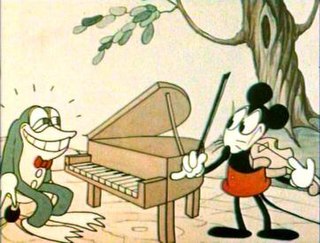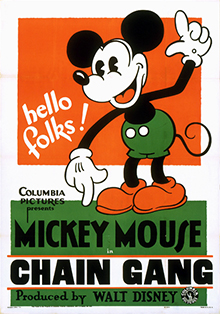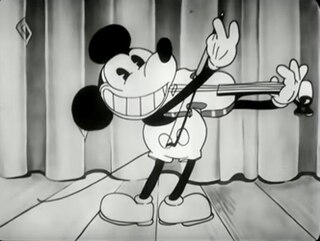Related Research Articles

Mickey Mouse is an American cartoon character co-created in 1928 by Walt Disney and Ub Iwerks. The longtime icon and mascot of The Walt Disney Company, Mickey is an anthropomorphic mouse who typically wears red shorts, large yellow shoes, and white gloves. Inspired by such silent film personalities as Charlie Chaplin and Douglas Fairbanks, Mickey is traditionally characterized as a sympathetic underdog who gets by on pluck and ingenuity in the face of challenges bigger than himself. The character's depiction as a small mouse is personified through his diminutive stature and falsetto voice, the latter of which was originally provided by Disney. Mickey is one of the world's most recognizable and universally acclaimed fictional characters.

Ubbe Ert Iwerks, known as Ub Iwerks, was an American animator, cartoonist, character designer, inventor, and special effects technician, known for his work with Walt Disney Animation Studios in general, and for having worked on the development of the design of the character of Mickey Mouse, among others. Born in Kansas City, Missouri, Iwerks grew up with a contentious relationship with his father, who abandoned him as a child. Iwerks met fellow artist Walt Disney while working at a Kansas City art studio in 1919.

Plane Crazy is a 1928 American animated short film directed by Walt Disney and Ub Iwerks. The cartoon, released by the Walt Disney Studios, was the first appearance of Mickey Mouse and his girlfriend Minnie Mouse, and was originally a silent film. It was given a test screening to a theater audience on May 15, 1928, and an executive from Metro-Goldwyn-Mayer saw the film, but failed to pick up a distributor. Later that year, Disney released Mickey's first sound cartoon, Steamboat Willie, which was an enormous success; Plane Crazy was officially released as a sound cartoon on March 17, 1929. It was the fourth Mickey film to be given a wide release after Steamboat Willie, The Gallopin' Gaucho and The Barn Dance (1929).

Minnie Mouse is a cartoon character created by The Walt Disney Company. As the longtime sweetheart of Mickey Mouse, she is an anthropomorphic mouse with white gloves, a red or pink bow, blue polka-dotted dress, white bloomers and low-heeled shoes occasionally with ribbons on them. The Mickey Mouse comic strip story "The Gleam" by Merrill De Maris and Floyd Gottfredson first gave her full name as Minerva Mouse, although this is seldom used.
The golden age of American animation was a period in the history of U.S. animation that began with the popularization of sound synchronized cartoons in 1928, gradually ending in the 1960s when theatrical animated shorts started to lose popularity to the newer medium of television. Animated media from after the golden age were produced on cheaper budgets and with more limited animation techniques between the 1960s and 1970s. The theatrical animation of the golden age peaked in the 1930s and 1940s, while the period is subdivided as the silver age for the rest of its animation produced in the 1950s and 1960s; which includes the latest theatrical animations produced by Walt Disney and Walter Lantz, the latest theatrical cartoons of MGM and Warner Bros., Hanna-Barbera's earliest animated television series and DePatie–Freleng's earliest theatrical cartoons. Furthermore, the history of animation became very important as an artistic industry in the United States.

Flip the Frog is an animated cartoon character created by American animator Ub Iwerks. He starred in a series of cartoons produced by Celebrity Pictures and distributed by Metro-Goldwyn-Mayer from 1930 to 1933. The series had many recurring characters besides Flip, including Flip's dog, the mule Orace, and a dizzy neighborhood spinster.

The Chain Gang is a 1930 Mickey Mouse animated film produced by Walt Disney Productions for Columbia Pictures, as part of the Mickey Mouse film series. It was the twenty-first Mickey Mouse short to be produced, the sixth of that year. It is one of a group of shorts of strikingly uneven quality produced by Disney immediately after Ub Iwerks left the studio.

The Gallopin' Gaucho is a 1928 American animated short film and the second short film featuring Mickey Mouse to be produced, following Plane Crazy and preceding Steamboat Willie. The Disney studios completed the silent version in August 1928, but did not release it in order to work on Steamboat Willie. The Gallopin' Gaucho was released, with sound, after Steamboat Willie on December 30 of the same year.

The Laugh-O-Gram Studio was an animation studio located on the second floor of the McConahay Building at 1127 East 31st in Kansas City, Missouri, that operated from June 28, 1921, to October 16, 1923.

Patrick Anthony Powers was an American producer who was involved in the movie and animation industry of the 1910s, 1920s, and 1930s as a distributor and producer. He established Powers Moving Picture Company, also known as Powers Picture Plays. His firm, Celebrity Productions, was the first distributor of Walt Disney's Mickey Mouse cartoons (1928–1929). After one year, Disney split with Powers, who started another animation studio with Disney's lead animator, Ub Iwerks.

Wild Waves is a Mickey Mouse short animated film first released on December 18, 1929, as part of the Mickey Mouse film series. It was the fifteenth Mickey Mouse short to be produced, the twelfth of that year, as well as the last to be released by Celebrity Productions before Columbia Pictures took over distribution.

The Barn Dance is a Mickey Mouse short animated film first released on March 15, 1929, as part of the Mickey Mouse film series; it was the first of twelve shorts released during that year. It was directed by Walt Disney with Ub Iwerks as the head animator. The title is written as Barn Dance on the poster, while the full title is used on the title screen.

The Opry House is a 1929 Mickey Mouse short animated film released by Celebrity Pictures, as part of the Mickey Mouse film series. It was the fifth Mickey Mouse short to be released, the second of that year. It cast Mickey as the owner of a small theater. Mickey performs a vaudeville show all by himself. Acts include his impersonation of a snake charmer, his dressing in drag and performing a belly dance, his caricature of a Hasidic Jew and, for the finale, a piano performance of Hungarian Rhapsody No. 2 by Franz Liszt.

The Karnival Kid is a 1929 Mickey Mouse short animated film released by Celebrity Productions, as part of the Mickey Mouse film series. It was directed by Walt Disney and animated by Ub Iwerks, with music by Carl W. Stalling. It was the ninth Mickey Mouse short to be produced, the sixth of that year.

Steamboat Willie is a 1928 American animated short film directed by Walt Disney and Ub Iwerks. It was produced in black and white by Walt Disney Studio and was released by Pat Powers, under the name of Celebrity Productions. The cartoon is considered the debut of both Mickey and Minnie Mouse, although both characters appeared several months earlier in a test screening of Plane Crazy. Steamboat Willie was the third of Mickey's films to be produced, but it was the first to be distributed, because Disney, having seen The Jazz Singer, had committed himself to produce one of the first fully synchronized sound cartoons.

When the Cat's Away is a Mickey Mouse short animated film first released on May 3, 1929, as part of the Mickey Mouse film series. It was directed by Walt Disney and animated by Ub Iwerks and Ben Sharpsteen. It was the sixth Mickey Mouse short to be produced, the third of that year. In this cartoon, Mickey and Minnie are the size of regular mice, and Tom Cat is the size of a person.

Mickey's Choo-Choo is a 1929 Mickey Mouse short animated film released by Celebrity Pictures, as part of the Mickey Mouse film series. Ub Iwerks was the animator. It was the eleventh Mickey Mouse short to be produced, the eighth of that year, and was one of the series of early Disney cartoons that led Mickey Mouse to become a national fad by the end of 1929. Originally produced in black and white, this cartoon was one of 45 Mickey Mouse cartoons colorized by American Film Technologies in 1991.

Fiddlin’ Around is a 1930 animated short film produced by Walt Disney Productions and released by Columbia Pictures as part of the Mickey Mouse film series. It was the sixteenth Mickey Mouse short to be produced, the first of that year.

Mickey's Follies is a Mickey Mouse animated short film first released on August 28, 1929, as part of the Mickey Mouse film series. It was directed by Ub Iwerks and Wilfred Jackson, with music by Carl Stalling. It was produced in black and white by The Walt Disney Studio and released to theaters by Celebrity Productions. It was the tenth Mickey Mouse short to be produced, the seventh of that year.

The Haunted House, also known as Haunted House, is a 1929 Mickey Mouse short animated film released by Celebrity Productions, as part of the Mickey Mouse film series. The cartoon was produced by Walt Disney Productions and distributed by Celebrity Productions. It was the fourteenth Mickey Mouse short to be produced, the eleventh of that year.
References
- ↑ Bradley, Edwin M. The First Hollywood Sound Shorts, 1926–1931. p. 225.
- ↑ Lenburg, Jeff (1999). The Encyclopedia of Animated Cartoons. Checkmark Books. p. 80. ISBN 0-8160-3831-7 . Retrieved June 6, 2020.
- ↑ Robertson, Patrick (2011). Robertson's Book of Firsts. London: Bloomsbury. ISBN 9781608197385 . Retrieved May 24, 2017.
- ↑ Barrier, Michael (1999). Hollywood cartoons: American animation in its golden age. Oxford University Press. p. 50. ISBN 0-19-503759-6.
- ↑ Mortimer Mouse - D23
- ↑ Esberg, Dan (January 14, 2018). "It's About Time Ub Iwerks Got His Credit" . Retrieved May 28, 2022.